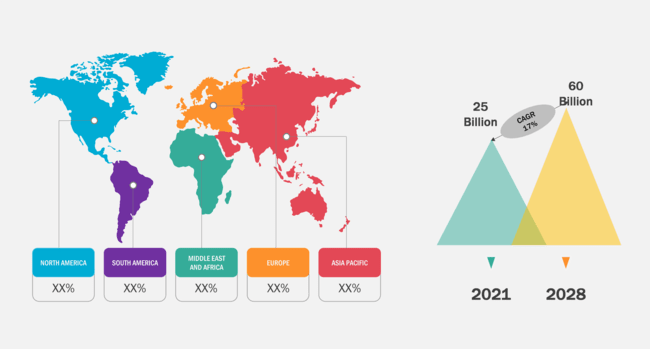Microgrid market size is expected to reach US$ 60 billion by 2028; registering at a CAGR of 17.0% during 2022–2028, according to a new research study conducted by The Insight Partners.
Advancements in Microgrid to support Microgrid Market Growth in Coming Years
Microgrid Market Size and Forecasts (2021 - 2031), Global and Regional Share, Trends, and Growth Opportunity Analysis Report Coverage: By Type (Grid Connected and Off-Grid), Components (Hardware, Software, and Services), End-Use Industry (Military, Healthcare, Government and Utilities, Institutes, Industrial, and Others), and Geography (North America, Europe, Asia Pacific, and South and Central America)
Microgrid Market Size and Forecasts (2021 - 2031), Global and Regional Share, Trends, and Growth Opportunity Analysis
Download Free Sample
Source: The Insight Partners Analysis
The demand for microgrids is growing exponentially across the world. With concept of smart cities is getting commercialized, the different regional & country-level government are focusing on encouraging renewable resources for electricity generation. This factor will propel the scope of microgrid also. Grid-connected microgrids can aid in a larger reach of renewable energy sources, thereby economically benefitting, both, grid operators and end users. Therefore, with the absolute volume of microgrid deployments, along with the challenges associated with grid operations, advanced microgrids are likely to become a norm in utilities across the world.
In the last few years, microgrid deployments have increased across the world. The snowballing of annual microgrid capacities, increasing spending by countries such as the US on microgrids, and preferred electrification of vehicles and transportation are creating new growth opportunities for companies operating in the microgrid market. With the development of legislation in various countries, states, and communities to reach net-zero carbon emission goals, coupled with the greater integration of renewables into the grid, the adoption rate of microgrid is expected to fuel up. This growth is expected to further make a change toward more advanced microgrid development. Systemic microgrid standardization is the next logical step that is likely to benefit microgrid developers and end users. Subsequently, the acceptance of microgrid control standards such as IEEE 2030.7-2017 is paving the path for the development of more standards.
In addition to the introduction of microgrids in large urban areas, the need for proper cybersecurity is getting prevalent. Cybersecurity requirements vary across commercial, industrial, and utility microgrid installations. Therefore, the development of comprehensive cybersecurity standards is a must to protect future microgrid infrastructures. Considering the focus of the cybersecurity requirements specified by the US Department of Defense (DoD), third-party validation and testing should be implemented as a standard practice for every microgrid, instead of prioritizing only the federal ones. Microgrid manufacturers need to ensure the security of assets involved in microgrids to strengthen their role as a new backbone of a grid infrastructure. With continuous changes in microgrids, they are likely to prove as a suitable alternative for other non-wired solutions in a broader range of applications.
Thus, with advancements in terms of standardization, cybersecurity, and grid-connected operations, microgrids are likely to come up as a prominent solution to fulfill future power demands.
ABB Ltd., Schneider Electric SE, Eaton Corporation, and General Electric are among the key players in the microgrid market, which are profiled during the study. Moreover, several other major companies have been studied and analyzed to get a holistic view of the microgrid market and its ecosystem.